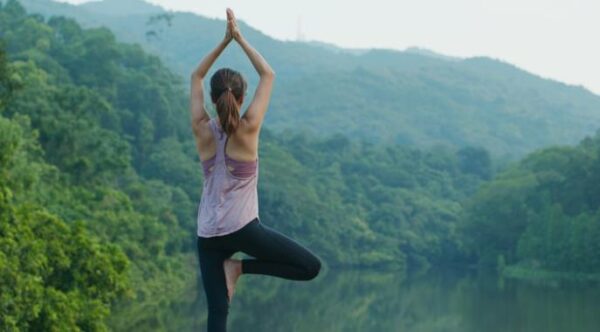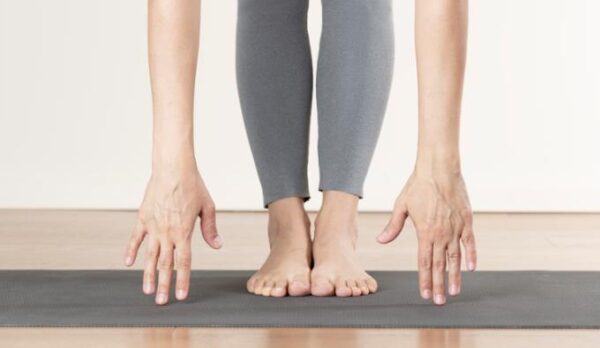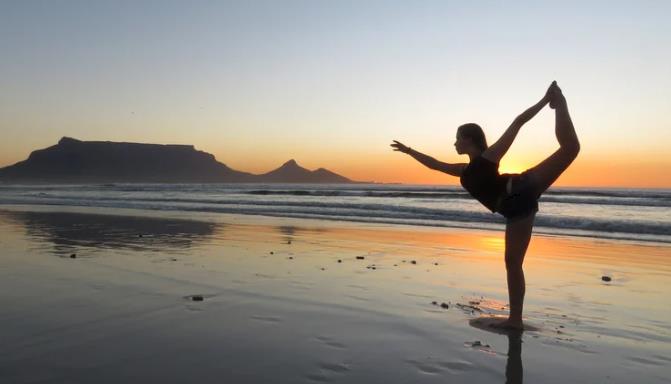Bird of Paradise Yoga is a yoga pose that combines elements of balance, strength, and flexibility. In this pose, one leg is extended while the other is bent, with the arms wrapped around the extended leg. The posture resembles a bird spreading its wings, hence the name “Bird of Paradise.” It requires core stability, hip flexibility, and shoulder strength to execute properly. Bird of Paradise Yoga is often included in advanced yoga practices and can be challenging for beginners. Join us on this journey as we uncover the beauty and benefits of mastering the Modified Bird of Paradise Pose.
Exploring the History and Origin of Bird of Paradise Pose

The Bird of Paradise Pose, also known as Svarga Dvijasana in Sanskrit, has a rich history deeply rooted in the ancient practice of yoga. Originating from the traditional Hatha Yoga system, this pose symbolizes freedom and grace. It is believed to have been inspired by the vibrant and exotic bird native to Indonesia.
The graceful movement and elegance embodied in the Bird of Paradise Pose reflect the beauty of nature and its connection to spiritual growth. The posture challenges practitioners both physically and mentally, encouraging them to cultivate strength, balance, and flexibility.
Over time, this challenging asana has gained popularity worldwide for its unique fusion of strength-building elements with fluidity and poise. As yogis delve deeper into their practice, they uncover layers of symbolism within this pose that resonate with personal growth and transformation.
Exploring the history behind Bird of Paradise Pose allows us to appreciate not only its physical benefits but also its spiritual significance in connecting mind, body, and spirit on the mat.
Benefits of Practicing Bird of Paradise Yoga
Practicing Bird of Paradise yoga offers a myriad of benefits for both the body and mind. This advanced pose helps to improve balance, strength, and flexibility all at once. By engaging multiple muscle groups simultaneously, Bird of Paradise pose challenges your core stability and enhances overall coordination.
Additionally, this dynamic posture encourages spinal extension, which can help alleviate back pain and improve posture over time. The deep stretch in the shoulders, chest, and hamstrings promotes greater mobility in these areas while also releasing tension that accumulates from daily activities or stress.
Mentally, mastering Bird of Paradise requires focus and concentration, helping to cultivate mindfulness during practice. As you progress in this pose, you may experience a sense of achievement and empowerment that extends beyond the mat into your everyday life.
Psychological Benefits of Practicing Bird of Paradise Pose
Practicing the Bird of Paradise pose in yoga offers not only physical benefits but also significant psychological and emotional advantages. This challenging pose demands focus and concentration, which can help cultivate a more disciplined and mindful approach to life’s challenges. Here are some key psychological benefits:
- Enhanced Mental Clarity: Achieving and maintaining the Bird of Paradise pose requires mental focus, which can help clear the mind of clutter and reduce stress. This enhanced clarity can improve decision-making skills and increase productivity in daily activities.
- Boosted Self-Esteem: Mastering a complex pose like the Bird of Paradise can provide a significant boost to self-esteem and self-confidence. As practitioners progress in their ability to perform this pose, they often experience a sense of accomplishment that can enhance their overall self-image.
- Emotional Resilience: The balance and strength required for this pose can help individuals develop emotional resilience. The physical challenge encourages persistence and patience, qualities that are transferable to coping with emotional and psychological stress.
- Mindfulness and Presence: The intensive focus required to execute the Bird of Paradise pose promotes a state of mindfulness, which can help practitioners become more aware of the present moment and less reactive to external stresses.
- Reduction in Anxiety and Depression: Regular practice of yoga, including advanced poses like Bird of Paradise, has been shown to reduce symptoms of anxiety and depression. The physical activity combined with mindful breathing can lead to an overall improvement in mood and emotional well-being.
Step-by-Step Guide to Bird of Paradise Yoga Pose
Here’s a step-by-step guide to practicing Bird of Paradise Pose:
- Begin standing tall at the front of your mat with your feet hip-width apart and your arms relaxed by your sides.
- Shift your weight onto your right foot and ground down through the entire sole of your foot, finding stability and balance.
- Engage your core muscles to maintain a strong and steady center as you lift your left foot off the ground.
- Bend your left knee and draw it towards your chest, using your hands to support the leg if needed.
- Once your left knee is lifted towards your chest, reach your left arm around the outside of your left knee, hooking your fingers or hands together.
- Extend your right arm straight up towards the sky, keeping your gaze steady and focused.
- Begin to straighten your left leg as you simultaneously lift your torso and chest upwards.
- Slowly begin to straighten your left leg out in front of you, finding length and extension through the entire leg.
- Keep your core engaged and your spine long as you slowly hinge forward from the hips, maintaining a steady and controlled movement.
- Continue to reach your right arm upwards towards the sky, finding length and expansion through the entire side body.
- Once your left leg is fully extended and your torso is parallel to the ground, pause and breathe deeply.
- Hold the pose for several breaths, finding stability and ease in the posture.
- To release the pose, slowly bend your left knee and lower your left foot back down to the ground.
- Return to standing tall at the front of your mat and take a moment to pause and reflect on your experience.
- Repeat the pose on the opposite side, grounding down through your left foot and lifting your right leg to find balance and stability.
Remember to approach Bird of Paradise Pose with patience, mindfulness, and a sense of exploration. Honor your body’s limitations and listen to your own inner wisdom as you journey through each step of the pose. With practice and dedication, you’ll gradually cultivate strength, flexibility, and grace in both body and mind.
Modifications and Variations for Bird of Paradise Pose
Looking to add some spice to your Bird of Paradise Pose practice? Let’s talk modifications and variations!
If you’re a beginner, using props like blocks can help with balance and stability as you work on mastering the pose. Try keeping your gaze soft and steady to maintain focus throughout the transition.
For those seeking a challenge, experiment with binding your hands behind your back or straightening the standing leg for an added stretch. Remember, it’s all about finding what feels good in your body while pushing yourself just enough to grow.
Don’t be afraid to play around with different arm positions or foot placements to make Bird of Paradise Pose uniquely yours. Embrace the journey of exploration and discovery on your mat.
Preparatory Poses for Bird of Paradise Yoga

Before attempting the Bird of Paradise pose, it’s essential to prepare your body with a sequence of poses that will help open up and strengthen the necessary muscle groups. Start by warming up with some gentle stretches for your hamstrings and hip flexors.
Poses like Standing Forward Fold, Pyramid Pose, and Revolved Triangle are great options to increase flexibility in the legs and hips. Warrior II can also be beneficial for building strength in the legs while opening up through the chest and shoulders.
Incorporating balancing poses like Tree Pose or Dancer’s Pose can improve stability and focus, which are crucial elements when transitioning into more advanced postures like Bird of Paradise. Don’t forget to engage your core throughout these preparatory poses to support your spine as you move into deeper stretches.
By taking the time to properly warm up and build awareness in these key areas of the body, you’ll set yourself up for a successful practice when working towards mastering Bird of Paradise yoga pose.
Common Mistakes and How to Avoid Them in Bird of Paradise Pose
When practicing Bird of Paradise Pose, common mistakes can hinder your experience and progress. One frequent error is rushing into the pose without proper warm-up or preparation. Remember to engage in gentle stretches and movements to loosen up your body before attempting this advanced yoga posture.
Another mistake is forcing yourself into the full expression of the pose too soon. It’s essential to listen to your body and gradually work towards a complete posture over time. Respect your limits and avoid pushing beyond what feels comfortable for you.
Misalignment is also a common pitfall in Bird of Paradise Pose. Ensure that your hips are squared, your spine elongated, and your shoulders relaxed throughout the asana. Pay attention to proper alignment cues from instructors or use mirrors for self-correction during practice.
Neglecting breath awareness can impact both stability and ease in Bird of Paradise Pose. Focus on deep inhales and exhales to maintain a steady rhythm while holding the posture. Stay mindful of your breath throughout the entire sequence for a more balanced practice.
Contraindications and Safety Tips for Bird of Paradise Yoga
When practicing Bird of Paradise Yoga, it’s crucial to be aware of any contraindications and safety tips to ensure a safe and effective practice. If you have a history of hip or shoulder injuries, it’s essential to approach this pose with caution, as it requires strength and flexibility in these areas.
Pregnant individuals should avoid deep twists, and extreme balance poses like Bird of Paradise due to the risk of falling or putting excessive strain on the abdomen. It’s advisable for beginners or those with limited flexibility to work on building strength in the legs, core, and shoulders before attempting this advanced pose.
To prevent injury, always warm up properly before attempting the Bird of Paradise Pose. Listen to your body during the practice, and never force yourself into a position that feels uncomfortable. Remember that yoga is about mindfulness and self-awareness – honor your limits while exploring your potential.
Breathing Techniques for Enhancing Bird of Paradise Pose

When it comes to mastering the Bird of Paradise pose, proper breathing techniques play a crucial role in enhancing your practice. The breath is like a symphony that guides your movements and helps you find balance and stability in this challenging asana.
As you flow into the pose, focus on deepening your breath to create space within your body. Inhale deeply through your nose, allowing the air to expand your chest and lift you up toward the sky. Exhale slowly and mindfully, releasing any tension or resistance holding you back.
Syncing your breath with each movement can help you move more gracefully into the full expression of Bird of Paradise. Visualize yourself soaring like a majestic bird as you inhale strength and exhale doubt.
Remember that every inhale brings fresh energy, while every exhale allows for surrender and release. Embrace the rhythm of your breath as you flow through this empowering yoga posture, finding freedom and expansion with each mindful inhale-exhale cycle.
So roll out your yoga mat, breathe deeply, listen to your body, and embrace the journey towards achieving the graceful beauty of the Bird of Paradise pose.
Recommended Articles:
FAQs
1. What is the Sanskrit name for the Bird of Paradise yoga pose?
The Sanskrit name for the Bird of Paradise pose is “Svarga Dvijasana.”
2. What is Bird of Paradise yoga mythology?
The Bird of Paradise pose doesn’t have a specific mythology associated with it in traditional yoga texts. However, the name “Bird of Paradise” may evoke imagery of beauty, grace, and freedom, reflecting the qualities of the pose itself.
3. What is bird pose in yoga?
In yoga, the “bird pose” usually refers to “Pakshi Asana” or “Kakasana,” also known as the Crow pose. This posture involves balancing on the hands with the knees resting on the backs of the upper arms.
4. Why can’t I straighten my leg in Bird of Paradise?
Difficulty straightening the leg in the Bird of Paradise pose could be due to tightness or limited flexibility in the hamstrings, hips, or groin muscles. Regular practice, along with proper warm-up and stretching, can gradually improve flexibility and make straightening the leg easier.

Morgan is the creative force behind Stellar Lifestyle Collective, a platform dedicated to inspiring individuals to lead balanced, fulfilled lives. With a passion for wellness, beauty, travel, and personal growth, Morgan curates content that empowers readers to thrive in every aspect of their lives. Through insightful articles and practical advice, Morgan helps people make informed choices that enhance their everyday experiences.

